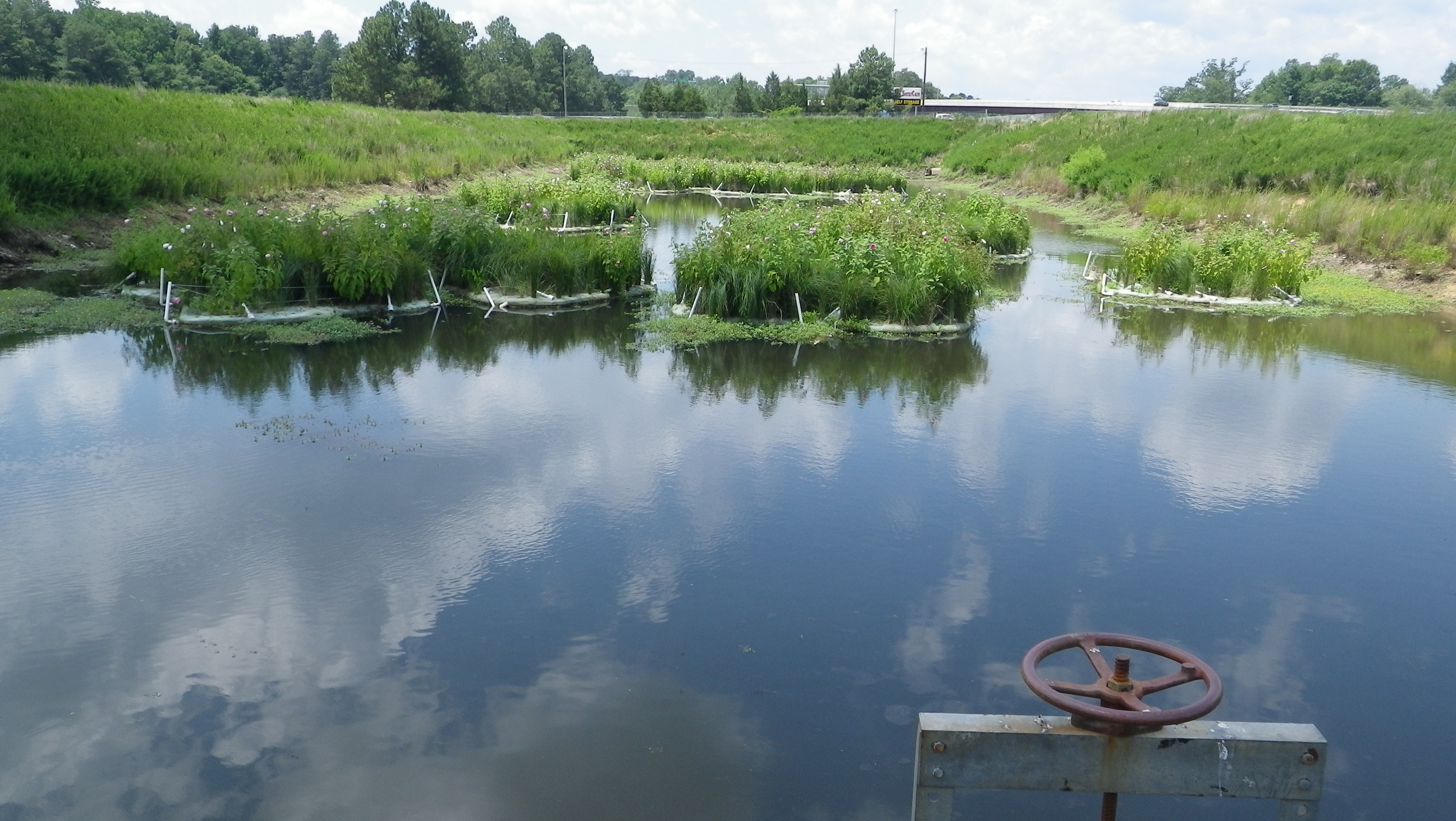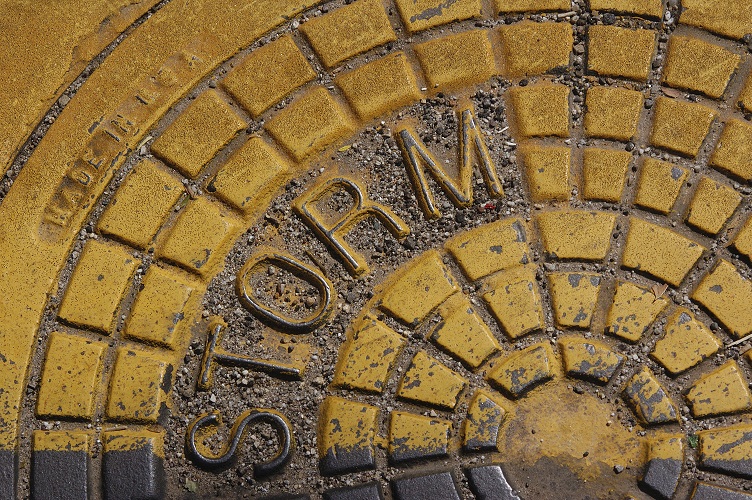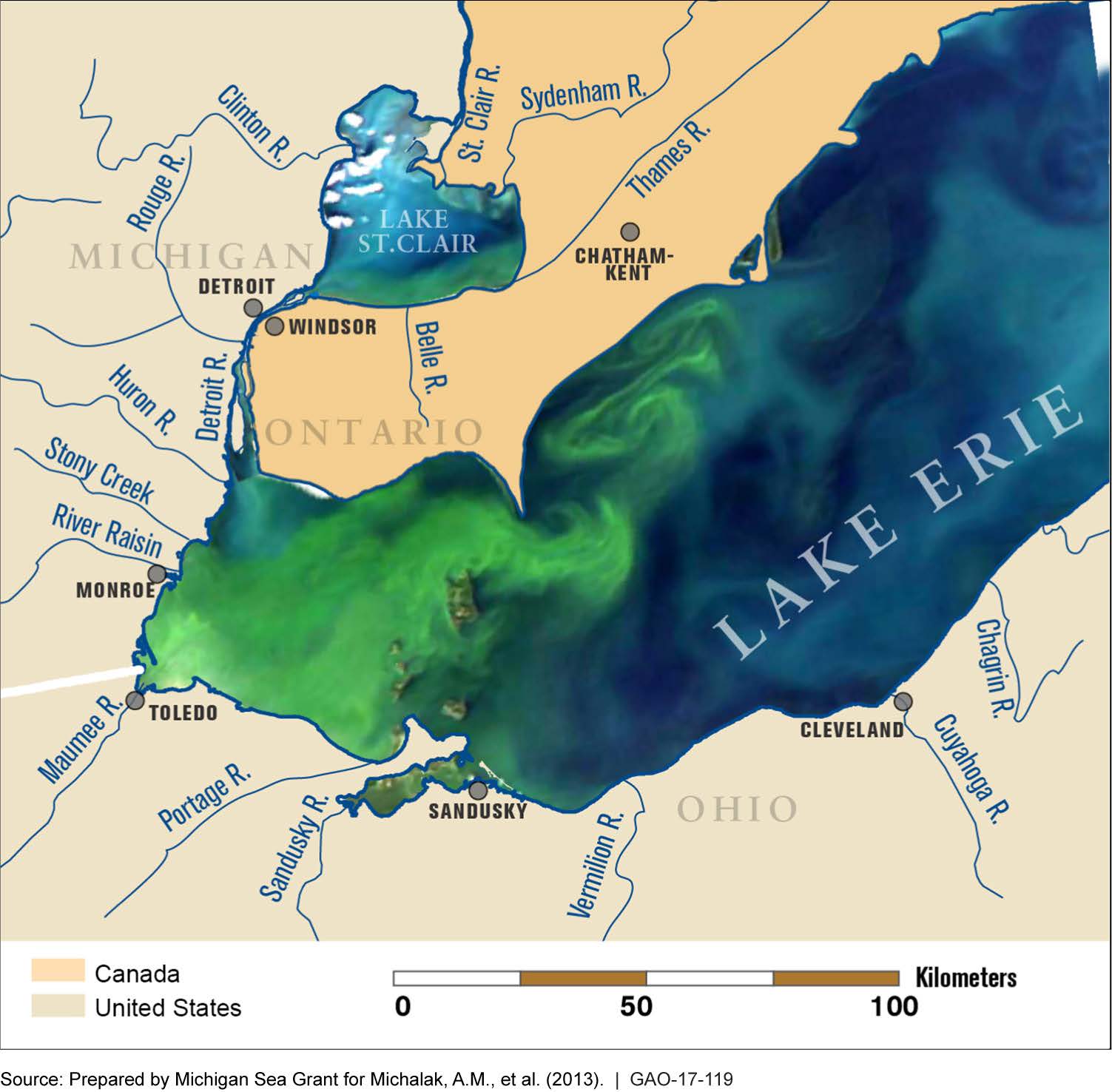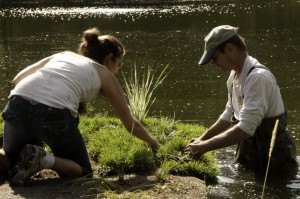
Volunteers plant a floating treatment wetland raft at Hayden Lake in Idaho. Image by Kootenai Environmental Alliance

Floating treatment wetlands in a large pond in Hyde Park, London, England. Image by Ryan Winston, NCSU
Floating treatment wetlands (FTWs) are an emerging innovation in green technology that have demonstrated significant potential for stormwater management. Research efforts and pilot installations in the U.S. and elsewhere have shown strong potential for the use of FTWs to remove nutrients and other contaminants from stormwater retention ponds.
FTWs are designed to float on the surface of a wet pond, providing a growing medium for emergent wetland plants. Floating mats or rafts are built in a way to support vegetation grown hydroponically — plant stems are held above water level with the roots submerged below the surface. This enables plants to draw in nutrients from the water column.
While FTWs represent a relatively newer option in stormwater treatment — gaining attention only in recent years for their potential to reduce nutrients and other contaminants — independent trials on these systems can be traced back as far as three decades.
“In the late 1980s and 1990s, FTWs were applied to the treatment of acid mine drainage in Canada with the results published in scientific literature,” said Chris Tanner, principal scientist of aquatic pollution management at the National Institute of Water and Atmospheric Research (Hamilton, New Zealand). “But over the last 10 years, we have seen a rapid expansion in the development of various experimental and commercial versions, including studies of their treatment potential.”
Targeting Nutrients, Suspended Solids, and Metals
Working with other researchers, Tanner conducted investigations near Auckland, New Zealand assessing the benefits of retrofitting a conventional retention pond with a FTW.
The field trial involved side-by-side monitoring of two parallel stormwater treatment ponds. Results showed that the pond retrofitted with an FTW was more efficient at reducing total suspended solids, particulate zinc, particulate copper, dissolved copper, and nitrogen and phosphorus.
According to study findings, physical entrapment of the particulate pollutants into the roots’ biofilm seemed to be a significant removal pathway. Because of higher humic content, lower dissolved oxygen, and a more neutral water column pH induced by the FTW, the researchers found greater potential for adsorption processes, precipitation as insoluble copper sulphides, and direct copper uptake by the plants. Microbial nutrient removal processes, such as nitrate conversion to nitrogen gases via denitrification, also may be stimulated through creation of localized anoxic zones beneath the mats, the researchers found.
“Floating wetlands have a number of advantages over conventional surface-flow wetlands for treatment of stormwater,” Tanner said. “Like conventional wetlands, they are very effective at promoting removal of suspended solids and associated contaminants, such as heavy metals and nutrients, and may also have the potential to enhance the removal of dissolved contaminants, such as nitrate and metals. However, FTWs have the advantage of being able to cope with fluctuating and deep water levels and are less prone to being smothered by settled sediments.”
As with most treatment systems, Tanner said, effectiveness is dependent on proper hydraulic design, including size relative to flows and contaminant loads.
FTWs for Reducing Stormwater Pollution
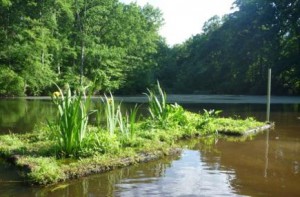
A floating treatment wetland at Ashby Pond in Fairfax, Va. Image courtesy of David Sample, Virginia Tech
At Virginia Polytechnic Institute and State University (Virginia Tech; Blacksburg, Va.), ongoing research is focused on evaluating the effectiveness of FTWs as low-cost, sustainable, engineered best management practices (BMP) for reducing pollution in stormwater.
David Sample, associate professor and extension specialist with the Department of Biological Systems Engineering at Virginia Tech, tested FTWs at project demonstrations in Fairfax and Virginia Beach, Va. He investigated the capacity of these systems to enhance nutrient removal processes in wet retention ponds.
FTWs could provide a means for meeting total maximum daily load (TMDL) reductions, Sample said, but quantifying an appropriate nutrient reduction credit is still difficult. “The effect of the floating raft, the plants, and the internal processes of the pond are intertwined,” he said. “Evaluating this reduction is an area of active research. The U.S. Environmental Protection Agency Chesapeake Bay program has an expert panel that is currently considering how credits should be allocated for the use of FTWs.”
Sample studies many small mesocosms as models of the FTW pond system. “Performance depends on coverage, pond volume, climate, and plant selection,” he said. “As a very rough estimate, we found that the net effect due to FTW plants is between 8% to 12% reduction of total nitrogen and 5% to 10% reduction of total phosphorus.”
At the Fairfax demonstration project, funded by the National Fish and Wildlife Foundation Chesapeake Bay Stewardship Fund, results indicated that three different FTW designs — including planted and unplanted floating mats — significantly improved the phosphorus and nitrogen removal efficiency of an urban retention pond simulated during the growing season.
“FTWs mimic some of the processes of natural wetlands and can be used to improve water quality by filtering, consuming, or breaking down pollutants such as nutrients, sediment, and metals from the water,” Sample said. “Because these systems occupy the surface of retention ponds, FTWs may represent a relatively low cost means of enhancing pollution reduction in stormwater.”
Compared to constructed wetlands, which are land intensive and have opportunity costs representing a large portion of the total costs, FTWs use land that is already being used for the pond surface, resulting in opportunity costs that are negligible, according to Sample.
Retrofitting to Stormwater Retention Ponds
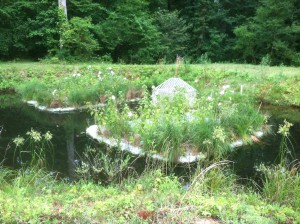
Two floating treatment wetlands surrounding the outlet structure of a stormwater pond in Durham, N.C. Image by Ryan Winston, NCSU
Thousands of wet retention ponds are located across the U.S. With research demonstrating the potential for FTWs to enhance the nutrient removal capacity of these ponds, researchers in the Department of Biological and Agricultural Engineering at North Carolina State University (NCSU; Raleigh) argue that FTWs could become a simple and popular retrofit.
FTWs are a particularly attractive retrofit option because these devices do not require earth moving, and they eliminate the need for additional land to be dedicated to treatment, according to NCSU researchers. And because they float, FTWs will not detract from the storage volume required for wet ponds.
An NCSU-led study of FTWs at two retention ponds in Durham, N.C., included a three-year-long monitoring program. Researchers evaluated the performance of FTWs for reducing nutrients and sediment. Measurements prior to and after FTW installation were taken at the two ponds, one of which contained FTWs that covered 10% of the pond surface and the other, 20%.
“The fraction of the pond surface covered by FTWs was the variable we wanted to isolate,” said Ryan Winston, a doctoral candidate with NCSU’s Department of Biological and Agricultural Engineering and lead researcher of the study.
Results showed that 10% FTW coverage did not improve pond performance for nutrient and sediment removal. However, the pond with 20% coverage displayed significant improvements in these parameters, suggesting that greater percent coverage with FTWs contributes to improved pollutant removal.
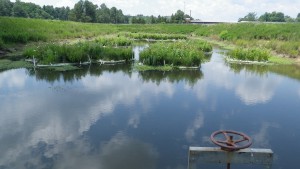
Floating treatment wetlands on a stormwater pond in Durham, N.C. Image by Ryan Winston, NCSU
“In retention ponds, settling is the method of treatment. FTWs help enable this process by stilling the flow of stormwater, allowing for more particles to settle,” Winston said.
In the study, FTWs were staggered in their placement in the retention pond. This strategic positioning was critical for impeding stormwater movement and provided a checking of flow velocity by forcing water to take a circuitous route, increasing retention time, Winston said.
The staggered placement of FTWs was also instrumental in helping increase pollutant uptake by the root systems.
“Water is forced to filter through the mass of roots that suspends 3 to 3.5 feet (0.9 to 1 m) from the FTW down into the water column,” Winston said. “This helps increase the adsorption of metals, and transfer of nutrients from the water to the plants.”
According to Winston, lab studies also have revealed that microbes inhabit the root zone, which is important in terms of encouraging nitrification. “The fact that FTWs have displayed plant and microbial effects that wouldn’t normally be found in a wet pond has helped fuel interest in their use as a BMP,” he said. “The state of North Carolina now provides an additional 5% credit towards TSS [Total Suspended Solids] removal for FTWs that cover at least 20% of the surface of a pond. Florida is considering a similar credit, and Chesapeake Bay is taking a hard look at FTWs in terms of nutrients.”
― Jeff Gunderson for The Stormwater Report

